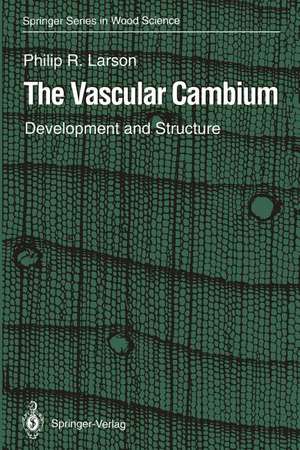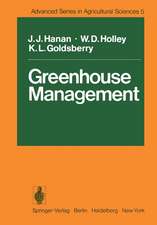The Vascular Cambium: Development and Structure: Springer Series in Wood Science
Autor Philip R. Larsonen Limba Engleză Paperback – 16 dec 2011
Din seria Springer Series in Wood Science
- 18%
 Preț: 1543.84 lei
Preț: 1543.84 lei - 23%
 Preț: 2062.71 lei
Preț: 2062.71 lei - 18%
 Preț: 1824.32 lei
Preț: 1824.32 lei - 18%
 Preț: 2093.60 lei
Preț: 2093.60 lei - 24%
 Preț: 817.70 lei
Preț: 817.70 lei - 18%
 Preț: 1225.16 lei
Preț: 1225.16 lei - 18%
 Preț: 3288.92 lei
Preț: 3288.92 lei - 18%
 Preț: 948.29 lei
Preț: 948.29 lei - 18%
 Preț: 1222.31 lei
Preț: 1222.31 lei - 18%
 Preț: 946.87 lei
Preț: 946.87 lei - 15%
 Preț: 643.34 lei
Preț: 643.34 lei - 18%
 Preț: 1122.87 lei
Preț: 1122.87 lei - 24%
 Preț: 836.40 lei
Preț: 836.40 lei - 20%
 Preț: 569.47 lei
Preț: 569.47 lei - 15%
 Preț: 638.89 lei
Preț: 638.89 lei - 15%
 Preț: 636.30 lei
Preț: 636.30 lei - 15%
 Preț: 635.31 lei
Preț: 635.31 lei - 18%
 Preț: 878.05 lei
Preț: 878.05 lei - 15%
 Preț: 646.43 lei
Preț: 646.43 lei - 18%
 Preț: 1004.67 lei
Preț: 1004.67 lei - 18%
 Preț: 894.03 lei
Preț: 894.03 lei - 15%
 Preț: 658.70 lei
Preț: 658.70 lei - 15%
 Preț: 641.53 lei
Preț: 641.53 lei - 18%
 Preț: 950.84 lei
Preț: 950.84 lei - 18%
 Preț: 783.35 lei
Preț: 783.35 lei - 15%
 Preț: 645.79 lei
Preț: 645.79 lei - 24%
 Preț: 880.78 lei
Preț: 880.78 lei -
 Preț: 388.13 lei
Preț: 388.13 lei - 18%
 Preț: 780.82 lei
Preț: 780.82 lei - 18%
 Preț: 891.65 lei
Preț: 891.65 lei
Preț: 1020.30 lei
Preț vechi: 1244.26 lei
-18% Nou
Puncte Express: 1530
Preț estimativ în valută:
195.23€ • 203.84$ • 161.58£
195.23€ • 203.84$ • 161.58£
Carte tipărită la comandă
Livrare economică 05-19 aprilie
Preluare comenzi: 021 569.72.76
Specificații
ISBN-13: 9783642784682
ISBN-10: 3642784682
Pagini: 748
Ilustrații: XV, 725 p.
Dimensiuni: 155 x 235 x 39 mm
Greutate: 1.03 kg
Ediția:Softcover reprint of the original 1st ed. 1994
Editura: Springer Berlin, Heidelberg
Colecția Springer
Seria Springer Series in Wood Science
Locul publicării:Berlin, Heidelberg, Germany
ISBN-10: 3642784682
Pagini: 748
Ilustrații: XV, 725 p.
Dimensiuni: 155 x 235 x 39 mm
Greutate: 1.03 kg
Ediția:Softcover reprint of the original 1st ed. 1994
Editura: Springer Berlin, Heidelberg
Colecția Springer
Seria Springer Series in Wood Science
Locul publicării:Berlin, Heidelberg, Germany
Public țintă
ResearchCuprins
1 Introduction.- 2 Fossil Evidence.- 3 Historical.- 3.1 Derivation of the Word Cambium.- 3.2 The Concept of Cambium as a Tissue.- 4 Defining the Cambium.- 4.1Cambial Cell Theories.- 4.2 Special Criteria.- 4.3 Reconciliation.- 4.4 Terminology.- 4.5 Special Features.- 5 Cambial Cell Characteristics.- 5.1 Cell Shape.- 5.2 Fusiform Initial Size.- 5.3 Ultrastructure.- 5.4 Cytochemistry.- 5.5 Cambial Cell Division.- 5.6 Cambial Aging.- 6 Anticlinal Cambial Divisions.- 6.1 Pseudotransverse and Transverse Divisions.- 6.2 Radial Anticlinal Divisions.- 6.3 Fates of Initial Cells.- 6.4 Tangential Increase of Cambium.- 6.5 Frequency of Anticlinal Divisions.- 6.6 Aberrant Anticlinal Divisions.- 6.7 Mechanism of Cell Elongation.- 7 Periclinal Cambial Divisions.- 7.1 Nonstoried Cambia.- 7.2 Storied Cambia.- 7.3 Anomalous Cambia.- 8 Rays.- 8.1 Medullary Rays - Historical.- 8.2 Classification of Rays.- 8.3 Ray Dynamics.- 8.4 Selected Examples.- 8.5 Radial Plates and Erect Cells.- 8.6 Effect of Eccentricity.- 8.7 Miscellaneous Features.- 9 Intercellular Spaces.- 9.1 Nonsecretory.- 9.2 Secretory.- 10 Cambial Wounding.- 10.1 Introduction.- 10.2 Barrier Zone.- 10.3 Mechanical Wounds.- 10.4 Ionizing Radiation.- 10.5 Biological Wounds.- 10.6 Environmental Factors.- 10.7 Cambial Marking.- 10.8 Cambial Electrical Resistance.- 10.9 Reconciliation.- 11 Cambial Zone Characteristics.- 11.1 Cambial Zonation.- 11.2 Radial Cell Wall Thickness.- 11.3 Number of Cambial Zone Cells.- 11.4 Cambial Reactivation.- 11.5 Alternation of Cambial Divisions.- 11.6 Mid-Season Growth Pause.- 11.7 Cambial Growth Cessation.- 11.8 Discontinuous and Missing Growth Rings.- 11.9 Complete Maturation of the Cambium.- References.
Recenzii
"The book is a major addition to anatomical literature...Larson has done a splendid job of summarizing the pertinent papers of the last 150 years." Plant Science Bulletin



